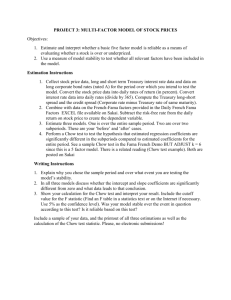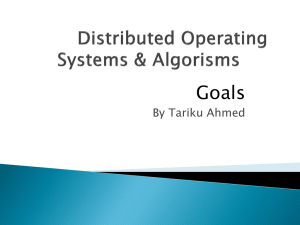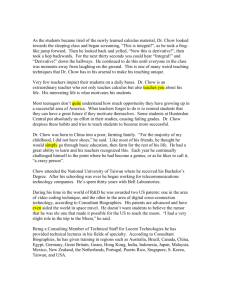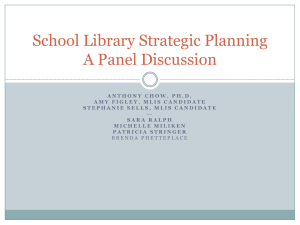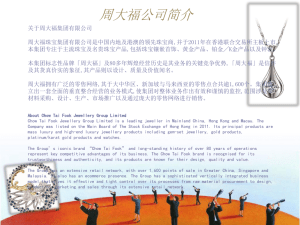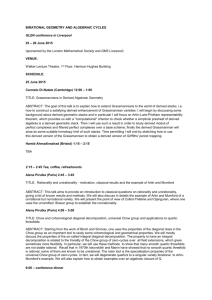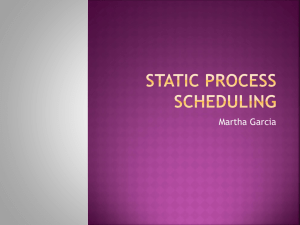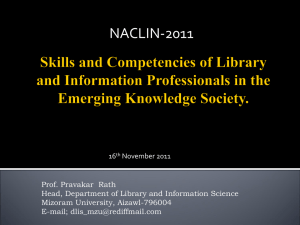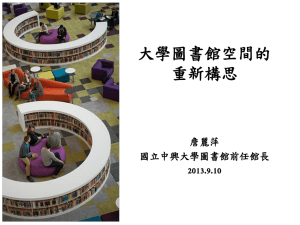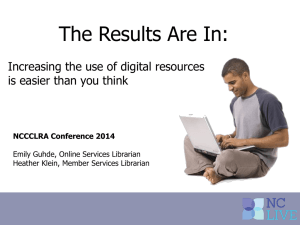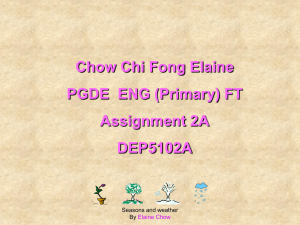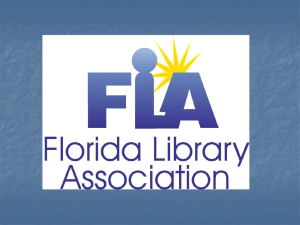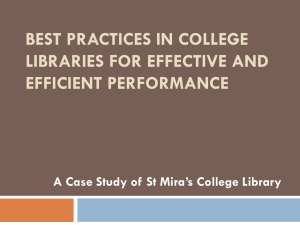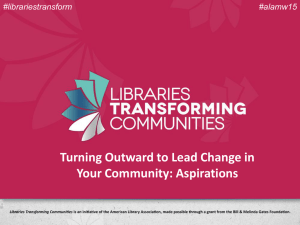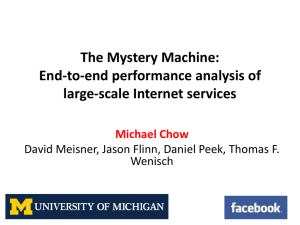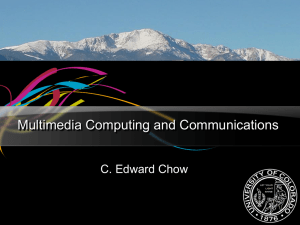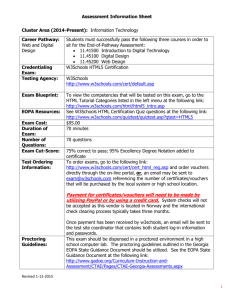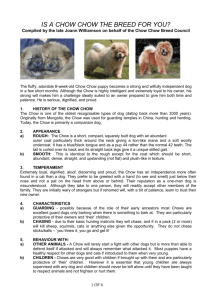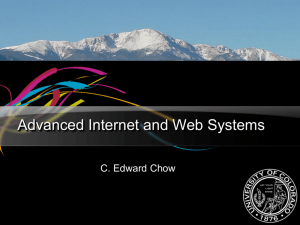Library Design & Technology. - The University of North Carolina at
advertisement
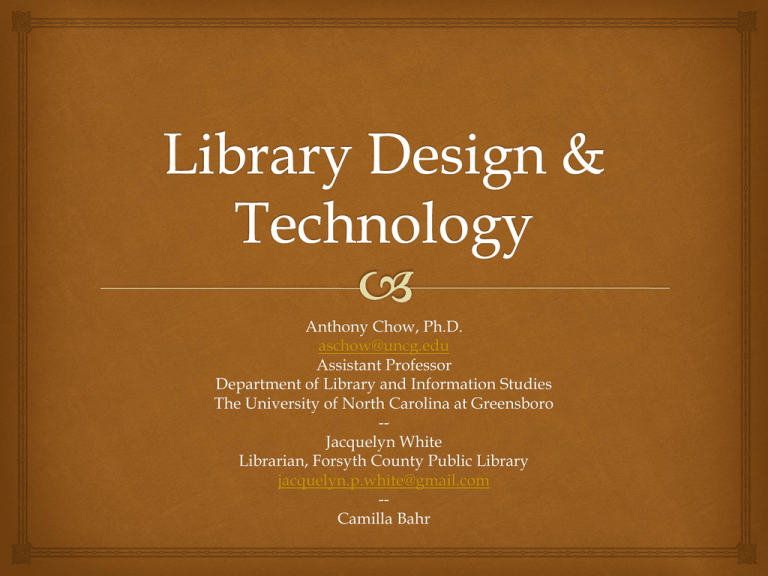
Anthony Chow, Ph.D. aschow@uncg.edu Assistant Professor Department of Library and Information Studies The University of North Carolina at Greensboro -Jacquelyn White Librarian, Forsyth County Public Library jacquelyn.p.white@gmail.com -Camilla Bahr Overview Study Introduction Personal examples User Trends Literature Review Research Method Findings Discussion and Recommendations 2 of 28 Introduction How are patrons using technology and interacting with library space? What are the library trends for design and technology usage? Case studies of Greensboro and Charlotte public libraries 3 of 28 Personal examples At work My kids Global communication Content creation At our public library 4 of 28 Users Drive Technology Solutions What the data tells us (Sources: ALA 2010; Chow& Bucknall, 2011) People are using libraries more than ever in all areas of librarianship 86% of families with school-aged children reported visiting the library (ALA, 2010) 18-24 (80%), 35-44 (73%), and 25-34 (70%) Top reasons for visiting a public library (more than one choice): 1. Books or associated media (77%) 2. Training and Education (41% listed as top choice) 3. Entertainment (35%) 4. Resumes, job searching, careers (22%) 5. Access to technology (17%) 5 of 28 User Technology Trends New article: What Students Don’t Know (Kolowich, 2011) Digital natives, including top students, are not very information literate Technology competence does not translate to information literacy (growing up Google does not mean you know how to use it) Virtual Reference study (Chow & Croxton, 2011) Faculty and staff prefer email and telephone Students prefer online chat (age was significant factor and covariate) Familiarity and convenience were the primary factors 6 of 28 User Technology Trends Nationwide public library study (Chow, Bridges, & Commander, 2011; n=1,219) 50% websites managed as part of his/her job 72% indicated no usability testing at all 49% offered virtual reference services (email – 83%, chat – 39%) Virtual users – 1 billion accounts worldwide largely 97% of all virtual accounts belong to 25 or under 10-15 year olds, 46% 15-25, 29% 5-10, 22% Virtual worlds and public libraries (Chow, Baity, Zamarripa, et al., 2011)? Collaborate with other library professionals worldwide; educational promise My kids? 40 accounts between them across six different worlds Social interaction and engagement Customize characters and do things they normally can’t Play games and help their characters “grow” 7 of 28 Literature “Investing money in technology and updated design to tempt more patrons to use their services, technology and spaces” (Mattern, 2007) PAT or Public Access Technology (Bertot, 2009): includes public-access computers, wireless (WiFi) access, ILSs, online databases, digital reference, downloadable audio and video, “…users want a customized experience while using technology designed for the general public, not the individual user…” (Bertot, 2009) 8 of 28 Literature (2) Six tenets in Library Design (Harrington, 2001) : 1. 2. 3. 4. Self-service and operational efficiency Extreme flexibility and integration of technology Green/sustainable buildings Collaboration between public and school/college libraries 5. A renewed interest in aesthetics 6. Customize the library to the local community 9 of 28 Literature (3) “So despite predictions of the death of the library due to the information revolution and the availability of digital resources, new library buildings are attracting renewed attention, and in some cases, increased usage.” (Turner & Davenport, 2005). “Libraries always have had a role in bringing communities together. Now, more than ever, they are serving multiple roles — as after-school youth centers, senior centers, job centers, and extensions of the town square. In many cases, libraries share locations with schools or community centers. As the pace of change in modem life accelerates, library design is changing too.” (Schatz & Williams, 2010). 10 of 28 Literature (4) “ ‘Just because we all have mobiles doesn't mean there still isn't a desire among people to interact with one another,’ cautioned architect Dennis Humphries of Humphries Poli, suggesting four-place computer stations where a family can use a computer together.” (Kuzyk & Fialkoff, 2011) 11 of 28 Method Administrator Interviews (2) Natural observations of two downtown libraries Observations were conducted on four different days with variation of time frames Observational Checklist created in Google Docs Form Sample 120 people 70% of those observed were male, with 84 males compared to 36 females 12 of 28 Findings Downtown library Users sat at computers but did not use the reading tables for reading or computing Rather they sat at smaller tables on the outside edges of the reading tables either reading or using their own digital devices The book store model – personal privacy 13 of 28 Findings 14 of 28 Findings (2) 15 of 28 Findings (3) 16 of 28 Findings (4) Gender # observed Females 36 Males 84 Total 120 Interaction with Staff 5 17 of 28 Space Usage Findings (5) Tables and chairs across from stairs 14 Main computer stations (circular computers and those in front of Reference desk) 34 Tables and chairs along the back walls left of stairs 3 Tables and chairs beside genealogy stacks 11 Personal computers near genealogy Library Technology Used Public Access Computers 66 Printers 2 Copiers 1 8 Wireless 19 Personal computers & tables in the Business connection center 12 Microfilms 2 Personal computers & tables next to periodicals 5 Other 11 18 of 28 Findings (6) Personal Technology Personal Technology Used Space Specifications 19 Type Used Laptop 15 PDA 1 Mobile device 1 Other 2 Number of computers 29 Number of printers 4 Number of copiers 3 Number of tables for 1 person 26 Number of tables for more than 1 person 26 19 of 28 Conclusions & Recommendations 1998 the space has not gone through any renovations since then relatively new yet the space felt dated. The colors are muted and dark, yet only appear in the furniture and carpet 20 of 28 User and Technology Match Remember top reasons patrons are coming to the public library: 1. Books or associated media (77%) 2. Training and Education (41% listed as top choice) 3. Entertainment (35%) 4. Resumes, job searching, careers (22%) 5. Access to technology (17%) 21 of 28 User and Technology Match 22 of 28 Recommendations User Centered Design – needs analysis and “functional” spaces based on patron usage patterns and needs Flexible, comfortable spaces recognizing “privacy” aspect of technology Some patrons need to use computers while others just need to access the wireless network and a place to work Ubiquitous computing expected – computing needs to be where the sources are. 23 of 28 Recommendations (2) “Going green can be the solution to budgets that can't budge…The solution: a hybrid building that will produce as much power as it uses.” (Brown, 2007) "Nobody really knows where technology is headed next," said architect Peter Bolek, Holzheimer, Bolek + Meehan, "[so] flexibility is key. You need to have the infrastructure in place to accommodate …the change" as libraries shift from hardware to being the "connection point or portal." (Kuzyk & Fialkoff, 2011) 24 of 28 Technology and Users Usability of technology and library space Utility (is it useful) and ease-of-use (efficient and effective) Well designed website based on user priorities and testing Library space designed to maximize efficiency and effectiveness of information seeking through technology Flexible, scalable, and designed for specific functional purposes – Books and media, training, entertainment, careers/jobs 25 of 28 Q&A New book: Library Technology and User Services (Chow & Bucknall, 2011) 26 of 28 Thank You!! 27 of 28 References ALA (American Library Association) (2010), The State of America’s Libraries – 2010. Chicago, IL: ALA. Alexander, P. (n.d.). Should You Lease or Buy Your Tech Equipment? Entrepreneur.com. Retrieved on August 24, 2011 from http://www.entrepreneur.com/technology/managingtechnology/article80230.html Chow, A., Baity, C., Zamarripa, M., Chappell, P., Rachlin, D. and Vinson, C. (2011), ‘Virtual Library Information Use and Users: A systems perspective’. Unpublished, Greensboro, NC, USA. Chow & Bucknall (2011). Library Technology and User Services. Oxford, England: Chandos Chow, A., Bridges, M. and Commander, P. (2011), ‘What does a typical library website look like? Results from a nationwide study.’ A paper to be presented at the North Carolina Library Association, October 4-7, 2011, Hickory, NC, USA Chow, A. and Croxton, R. (2011), Academic libraries, information seeking behavior, and virtual reference services: are there differences between university faculty, staff, and students? Reference User Services Quarterly, in press. Chow, White, & Bahr (2011). Public library space and technology. A paper to be presented at the Biennial North Carolina Library Association , October 4-7, 2011, Hickory, NC, USA Experian Hitwise (2011), Top 20 Sites & Engines. Accessed 14 April 2011, from Experian Hitwise: http://www.hitwise.com/us/datacenter/main/dashboard-10133.html Kolowich, S. (2011). What Students Don’t Know. Inside Higher Ed. Retrieved on August 24, 2011 from http://www.insidehighered.com/news/2011/08/22/erial_study_of_student_research_habits_at_illinois_university_libra ries_reveals_alarmingly_poor_information_literacy_and_skills McDougall, P. (2010), Tablets Will Replace One in Three PCs, Study Says. Accessed 11 April 2011, from Information Week: http://www.informationweek.com/news/storage/systems/showArticle.jhtml?articleID=228800307 w3schools.com (n.d.(b)), Browser Statistics. Accessed 19 April 2011, from w3schools.com: http://www.w3schools.com/browsers/browsers_stats.asp w3schools.com (2011), OS Platform Statistics. Accessed 14 April 2011, from w3cschools.com: http://www.w3schools.com/browsers/browsers_os.asp 28 of 28
